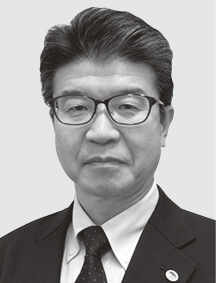Innovation for Next-generation Energy[ⅲ]Energy ManagementEnergy and Facilities Management Services for Enhancing Customer Value
Highlight
The energy and facility management services, EFaaS, provided by Hitachi are service-based solutions that provide the energy management and equipment management operations previously done by the customer as a package. Their platform-based data management improves operational efficiency and equipment operation, and assists optimized operation through areas such as energy use and preventive maintenance of equipment. Corporate finances are also improved by installing service-based systems and equipment that reduce initial investment. Hitachi’s EFaaS services help improve customers’ social value, environmental value, and economic value. This article provides an overview of these services, along with examples of how they have been adopted and their future outlook.
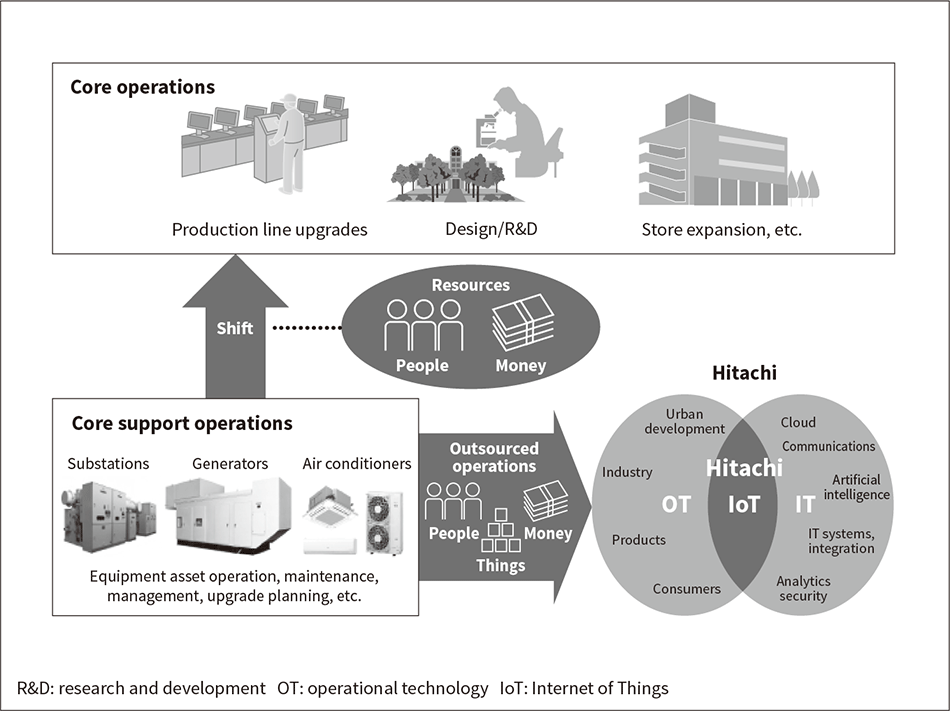
1. Introduction
Japan’s corporate management is being called on to place greater emphasis on dealing with Japan’s shrinking workforce and on environmental, social, and governance (ESG) factors. Work on saving energy and reducing CO2 emissions is being demanded of companies both inside and outside the manufacturing industry, while major changes are taking place in the business environment. A number of issues have been gaining prominence, such as equipment maintenance/management staff shortages and the aging of equipment built during Japan’s bubble years.
Japan’s energy policy is expected to promote the mass adoption of renewable energy in the coming years, but it also anticipates concurrent power grid instability due to power output fluctuations arising from renewable energy power sources. The creation of area-distributed energy management for stabilization is therefore a pressing challenge.
2. Overview of EFaaS
To respond to this challenge, Hitachi is attempting to create new business areas driven by cutting-edge technologies. One of these areas is energy and facilities management as a service (EFaaS).
While companies can focus on allocating resources to operations tied to profit growth, such as production line upgrades, design, research and development (R&D), and store expansion (core operations), they have difficulty allocating investment budgets for operations such as operation maintenance, management, and upgrading of transformers, generators, and air conditioners (core support operations). These operations are often handled with limited resources as a result. Hitachi has devised EFaaS as service-based solutions that reduce the amount of initial investment needed for core support operations while solving the challenges described. A single service provides energy management that covers energy transparency, analysis, and operation optimization, along with facilities management that outsources equipment upgrading and associated operations to improve operation management efficiency. The services provided cover core support operations and offer assistance that lets customers shift resources to core operations (see Figure 1).
Fig. 1—Overview of Hitachi’s EFaaS Services Hitachi’s energy and facilities management as a service (EFaaS) services let customers outsource all their equipment operation and management operations as a package, reducing their initial investment and increasing free cash flow.
Hitachi’s energy and facilities management as a service (EFaaS) services let customers outsource all their equipment operation and management operations as a package, reducing their initial investment and increasing free cash flow.
Customers that adopt Hitachi’s EFaaS services gain the following three benefits:
- Improved operations
Conventionally, each office has had to create reports on energy data and facility data, and had the head office administrative department manually compile and manage them. These operations are improved by managing the energy data from each office collectively on the cloud, where all of the energy data is compared to enable optimization, and control is performed as needed, helping reduce the energy consumption rate. These improvements reduce the data management workload for individual offices and the head office administrative department. - Improved operational efficiency in facilities management
Up to now, companies have carried out core support operations such as equipment management and document management independently at each office. These operations are improved by using databases and centralized management for equipment status management and other monitoring functions, and for budgeting of maintenance/failure history/upgrade planning using equipment management ledgers and maintenance inspection management. These improvements eliminate the need for individual management by each office, improving office operational efficiency. - Improved finance
Companies that install their own energy-saving or other new equipment need to make an initial investment and amortize the equipment. But having equipment provided as a service can lower the initial investment. It also lowers energy costs and levels costs, letting companies focus on core operations.
Hitachi’s EFaaS aims to provide a growing number of services for companies with multiple business hubs, and companies or groups that work in area redevelopment schemes such as industrial parks. The following sections present examples and benefits of EFaaS adoption among companies with several business hubs, along with Hitachi’s work on studying EFaaS for area redevelopment and plants.
3. EFaaS for Companies with Several Business Hubs
3.1 Energy Management Challenges for Manufacturers and Non-manufacturers
The growing emphasis being placed on environmental management is creating the following challenges for companies both inside and outside the manufacturing industry:
- Environmental measures
Today’s growing environmental awareness is creating the need for companies to work on decarbonization, and greater efforts are being made to reduce CO2 emissions, save energy, and optimize energy use. - Aging equipment
Equipment built during Japan’s bubble years is increasingly aging. Aging of equipment related to core support operations such as substations, generators, and air conditioners is particularly noticeable. But since equipment is not being properly maintained, failures result in unplanned operation shutdowns and losses that are harmful to business. - Workforce shortages and employee aging
Staff sizes, budgets, and various other reasons are making it impossible for companies to find all the onsite workers they need, forcing them to manage equipment with small crews. Companies are also not using databases to keep maintenance and inspection records, or records of background and handling information when problems occur. This lack of databases makes it impossible to check past cases, resulting in inadequate improvements in response measure efficiency. With experienced workers aging and leaving the workforce, the equipment management expertise they accumulated through experience is not being adequately passed on.
When equipment service life is prolonged by repairs and maintenance as a way to reduce investment, sudden equipment problems can result in unplanned costs and create a vicious cycle of balance sheet deterioration.
Hitachi has responded by devising EFaaS services that include energy management-based energy saving and energy optimization proposals, and facilities management-based methods of efficient equipment management and operation simplification. The services also cover finance that promotes equipment upgrades while reducing initial investment. Example uses and the future outlook for these services are presented below.
3.2 Energy Management Enabled by Upgrading Supermarket Air Conditioners
Fig. 2—Configuration of EFaaS System Installed at Kasumi Co., Ltd.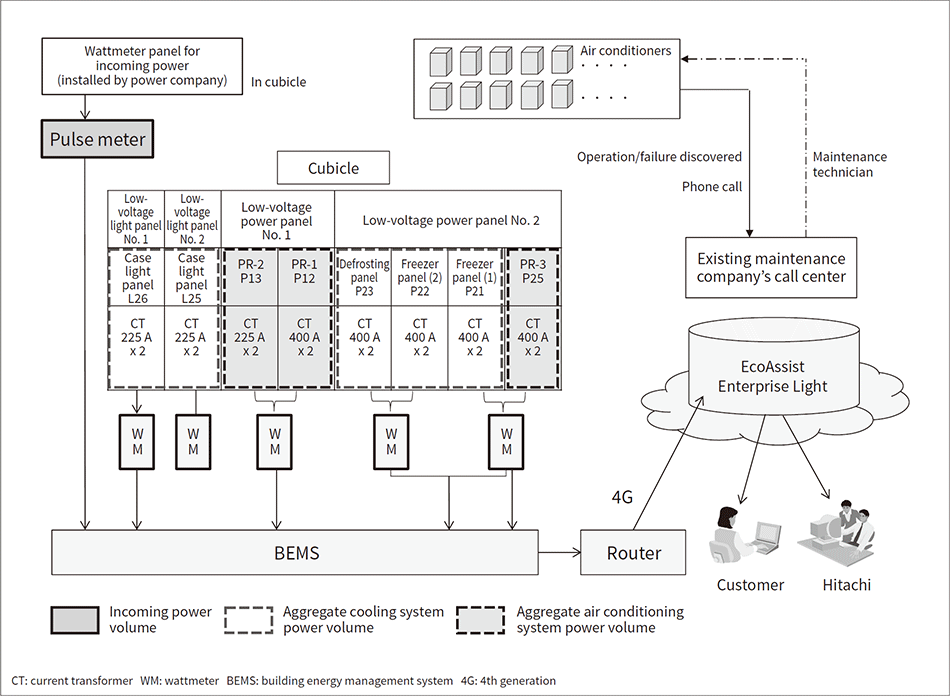 Current sensors were installed in equipment with high energy consumption such as in-store air conditioners, refrigerators, and freezers.
Current sensors were installed in equipment with high energy consumption such as in-store air conditioners, refrigerators, and freezers.
Kasumi Co., Ltd. is a chain of about 180 mostly street-based supermarkets that was grappling with the following two business continuity challenges:
- Staff shortages forced the company to handle complex equipment management with small crews. It was unable to maintain the equipment at all stores, and dealing with unplanned failures was resulting in losses.
- Inadequate work on saving energy
After uncovering these challenges through discussions with the customer, Hitachi analyzed each store’s energy efficiency from the store’s energy data and size (floor space). The results were used to select stores with poor operational efficiency. These stores were visited, and their equipment operation and aging were examined so that an upgrade plan could be proposed. Figure 2 shows the scope of the proposed upgrades and improvements. The proposals were for upgrades of air conditioners with noticeable aging, and for managed-energy operation made possible by installing current sensors on equipment with high energy consumption such as in-store freezers and refrigerators. Figure 3 shows an emergency management system (EMS) sample screen. This screen can display the energy consumption of the entire store, as well as values for individual air conditioners, refrigerators, and other equipment. When installing new equipment, initial costs were reduced by providing the equipment as a service. A way of improving the customer’s financial position was proposed by keeping costs off the balance sheet.
The service has now been adopted at five stores. Equipment upgrades and energy management were expected to provide an energy savings of 13.2%, and have nearly met this expectation on a single-month comparison basis.
Along with air conditioners, the service is also going to provide energy-optimized operation of in-store refrigerators and freezers with particularly high energy consumption, and will enable comprehensive management of equipment using digital technologies and the cloud. In the future, Hitachi aims to provide a complete management package covering all stores and building aspects, working to achieve win-win collaborative creation designed to solve the customer’s operational challenges.
Fig. 3—EMS Sample Screen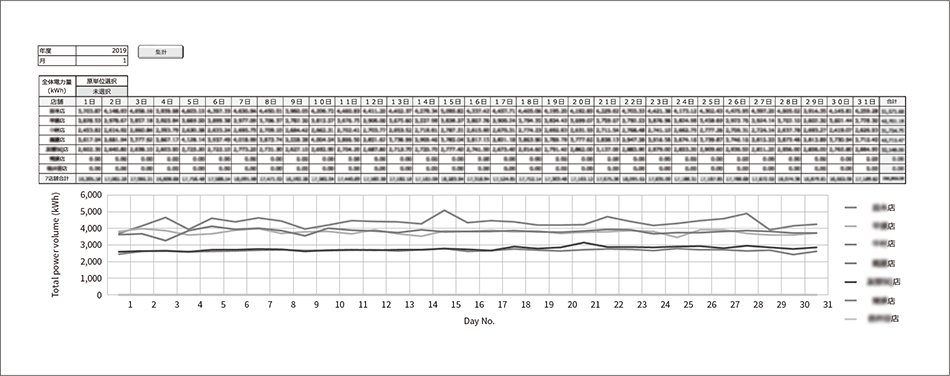 The screen shown can display the energy consumption of every store included in the energy management system (EMS). It can also show the energy consumption of individual air conditioners and freezers in each store, and compare energy consumption levels between stores.
The screen shown can display the energy consumption of every store included in the energy management system (EMS). It can also show the energy consumption of individual air conditioners and freezers in each store, and compare energy consumption levels between stores.
4. EFaaS for Area Redevelopment and Plants
Fig. 4—Overview of EFaaS for Area Redevelopment and Plants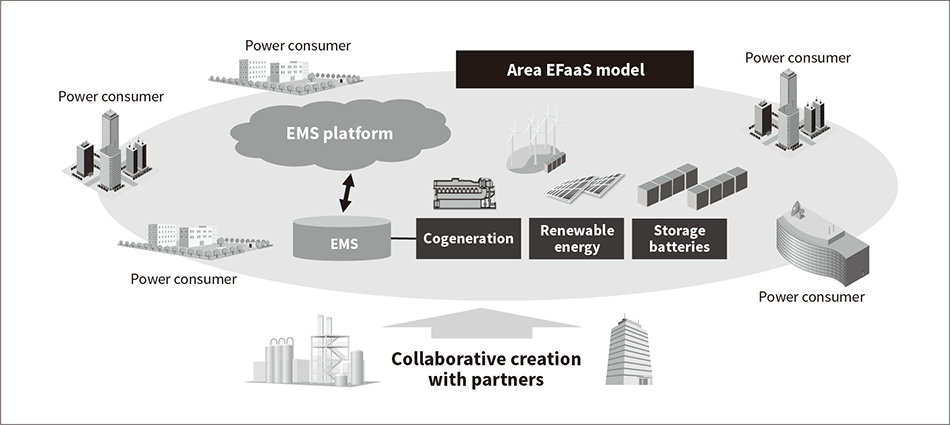 These EFaaS services use an EMS to manage energy demand within a single grid in the designated area. At the same time, they also manage the operation of equipment such as cogeneration facilities, renewable energy sources, and storage batteries. The EMS platform ensures overall energy optimization in the area.
These EFaaS services use an EMS to manage energy demand within a single grid in the designated area. At the same time, they also manage the operation of equipment such as cogeneration facilities, renewable energy sources, and storage batteries. The EMS platform ensures overall energy optimization in the area.
With the public increasingly calling for the use of renewables, companies need to work on reducing CO2 emissions from business activities and on creating business continuity plans (BCPs) when providing energy management for designated areas. Hitachi has responded by providing EMS and the Internet of things (IoT) platform-based services for equipment upgrades for area redevelopment, plants, etc. As shown in Figure 4, these services use an EMS to manage the energy demand from multiple power consumers (or multiple buildings in a single plant) on the same grid in a given area. At the same time, they also manage the operation of energy assets such as cogeneration systems, renewable energy sources, and storage batteries. The EMS platform is used to balance the area’s supply and demand, and to perform other operations to optimize energy use for both individual equipment items and as a whole. Another aim is to provide assistance for operations such as maintenance and energy services through collaborative creation with partners such as developers and energy providers.
To achieve this energy-optimized operation, work on popularizing renewable energy is being done in collaboration with the Hitachi Central Research Laboratory located in Kokubunji, Tokyo.
Installing area-wide renewable energy-driven distributed power supplies such as solar power facilities creates the problem of generation reductions, demand reductions, and other restrictions arising in the distribution grid. These restrictions have been overcome by actually installing distributed power supplies such as cogeneration systems and solar power facilities. The Central Research Laboratory was considered a single area and actual operation data acquired from the installed equipment was used to verify hypotheses such as how to efficiently operate equipment. This approach was designed to enable the elimination of restrictions and better profitability when installing distributed power supplies, while offering a way to provide services that will help popularize renewable energy. Through collaborative creation with customers, Hitachi will continue to develop new solutions that bring together conventional technologies with the research and demonstration findings described here.
5. Conclusions
This article has presented the service-based solutions that constitute Hitachi’s EFaaS services. These services overcome challenges stemming from Japan’s shrinking labor force through comprehensive management of energy and facilities using the cloud and databases. They promote environmental measures by reducing CO2 emissions, saving energy, and optimizing energy use. They also offer benefits such as helping to improve customers’ financial position by proposing new investment methods and equipment installation.
EFaaS services for companies with several business hubs let the client use its energy data to enhance its data analysis to a level of precision that is useful for making business decisions in areas such as how to approach store administration and store rollouts (investment). EFaaS services for area redevelopment and plants aim to provide customers with data useful for devising approaches to individual production activities from the standpoint of overall optimization, and useful for resilience (safety, security, and stability) and quality of life improvements (convenience, comfort, and the like).
Hitachi will work on bringing these future visions to life, providing EFaaS services that create new value by combining highly efficient energy equipment (products), along with operational technology (OT) and IT.


